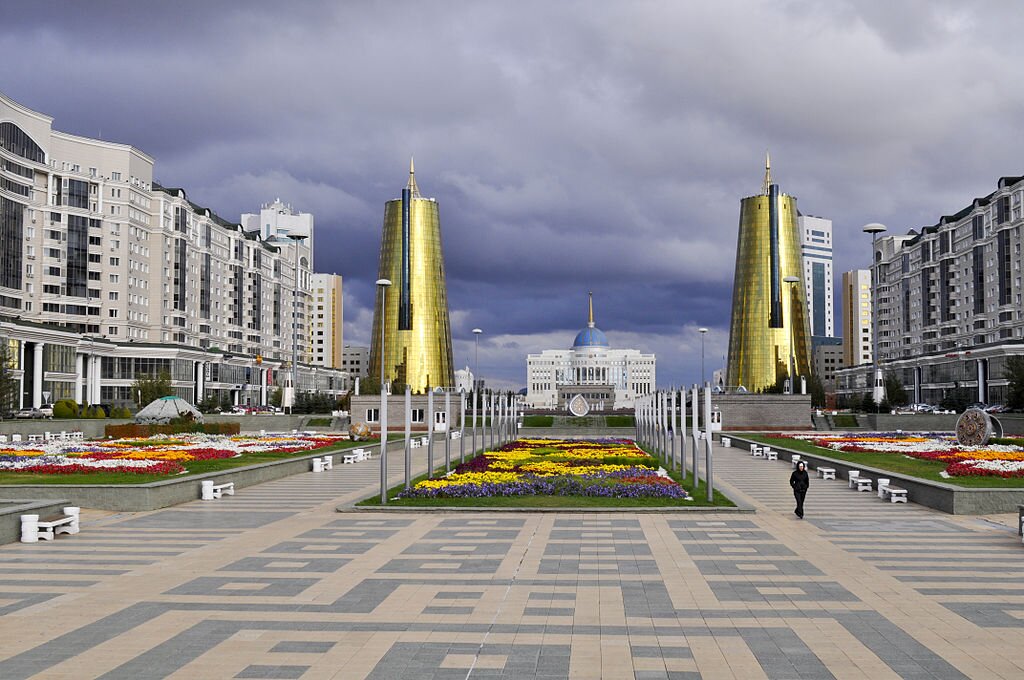Ellie Scheaffer is an undergraduate student at Oklahoma State University in Stillwater, Oklahoma, USA. She is majoring in German, with minors in Russian and Eastern European Studies as well as Central Asian Studies.
The 1998 relocation of Kazakhstan’s capital city from Almaty to Astana marked the creation of a contemporary Kazakh identity beyond its Soviet shadow. The (re-)construction of Astana has produced an enduring playground of otherworldly architecture with little preceding cultural legacy to guide its development. Even as President Nursultan Nazarbayev has succeeded in using Astana to create a more modern identity for contemporary Kazakhstan, its indulgent architecture is — for now, at least — neither "pragmatic" (more on that in a moment) nor expressive of the nation’s cultural heritage.
Over the past few years, Nazarbayev has promoted pragmatism as an inherently Kazakh trait, most recently in a 2017 press statement called "Course towards the Future." In the statement, Nazarbayev emphasized the development of Kazakh national identity as inextricably tied to a vision of the Kazakh future. Defining pragmatism as the “opposite of profligacy, arrogance, and a flashy lifestyle,” Nazarbayev highlighted the trait as a pillar of Kazakhstan’s twenty-first-century national consciousness. Yet nowhere is the irony of "pragmatism" as a watchword for Kazakhstan's future more evident than in the nation's recent architectural projects in Astana, which has taken shape under Nazarbayev’s direct control and planning.
The establishment of Astana as the new Kazakh capital opened it to architectural comparisons with its predecessor. Following its absorption into the Russian Empire in the 1850s, Almaty became an imperial fort complete with wide boulevards and public green spaces. Thus, the change in capitals, officially justified by Almaty’s volatile seismic location, might more accurately be seen as a deliberate break with Almaty’s colonial Russian and Soviet past — despite the fact that Astana itself had, as of the 1830s, served as a defensive fortification for the Siberian Cossacks and subsequently became Tselinograd, a central node in Nikita Khrushchev's Virgin Lands campaign. Renamed Aqmola after 1991 (in keeping with its original name of Akmoly), the city was to undergo several transformations starting in the late 1990s. Re-renamed Astana in 1998, the new capital quickly emerged as a locus of eccentric architecture and city planning.
Some Astana landmarks, such as the Khan Shatyr Entertainment Center and the Bayterek Tower, incorporate symbols of Kazakh legend and folklore in their structures. The Bayterek Tower, intended as a defining landmark of Astana, holds a golden egg in the nest of its peak — a reference to a nomadic tale in which the magical bird of Happiness, Samuk, weaves its nest in the Tree of Life before laying a golden egg. Atop this monument, visitors may place their hand in the palm imprint of President Nazarbayev, an act laden with the symbolism of emulation. The Khan Shatyr Center’s yurt-like form recalls that historical Kazakh housing structure. Though its promise to house a “world within” seems to draw on the yurt's traditional purpose, the Center's self-contained offerings do little to aid the organic, interactive development of the city’s landscape.
The architectural provenance of structures like the Golden Towers, the Shabyt Palace of Creativity, the Palace of Peace and Reconciliation, and the Kazakh State Circus is even more diffuse and varied. Framing Astana’s central axis, these buildings express a modern flair and succeed in breaking with the Russian-influenced appearance of cities like Almaty. At the same time, however, these structures set a garish stylistic tone seemingly out of keeping with Nazarbayev's vision of a pragmatic, modern, yet unequivocally Kazakh future.
Part of the issue is uncertainty about cultural precedent — a problem for any new, or newly liberated, nation. Without clear cultural touchstones, how can national identity grow? The new Astana is the manifestation of a drive toward modernization, which has produced a collection of futuristic buildings with little in common stylistically or culturally. Nazarbayev may frown on "flashiness," but he also spearheaded the planning of Astana, a living embodiment of flash. Indeed, its urban landscape flies in the face of the "traditional Kazakh pragmatism" Nazarbayev has repeatedly championed. In contrast to the rich cultural landscape of Almaty, admittedly guided by Russian influence and tradition, Astana can make a barren impression.
In his 2018 State of the Nation address, Nazarbayev signaled a possible return to pragmatism through the rubric of environmental sustainability. Kazakhstan's vast natural resources, which have accounted for as much as 74% of the nation's GDP (as of 2004), are not inexhaustible. Accordingly, Nazarbayev declared that Kazakhstan’s new obligation is to recognize that these resources cannot and will not last forever.
In light of the contrived and expensive development of Astana, it is tempting to think that this call to pragmatism of resources is too little, too late. In any case, Nazarbayev has proven his commitment to maintaining Astana’s high status, and under his leadership, the city celebrates its twentieth year. Festivities for Astana Day on July 6 will attract hundreds of thousands of people to the capital. Elaborate firework displays will glitter in the skies. Pragmatism will be forgotten, and Astana will have become Nazarbayev’s carefully constructed rallying point of modern Kazakh identity.



